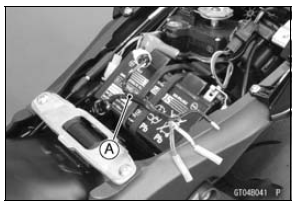

NOTE
Be sure the battery is fully charged.

Special Tool - Throttle Sensor Setting Adapter #1: 57001 -1400
Exhaust Butterfly Valve Actuator Sensor Input Voltage Connections to Adapter: Digital Meter (+) → Y/W (actuator W) lead Digital Meter (−) → BK/BL (actuator BK) lead

Input Voltage
Standard: DC 4.75  5.25 V
5.25 V
If the reading is within the standard, check the output voltage (see Exhaust Butterfly Valve Actuator Sensor Output Voltage Inspection).
If the reading is out of the standard, remove the ECU and check the wiring for continuity between main harness connectors.
Disconnect the ECU and sensor connectors.

Wiring Inspection ECU Connector [A] ←→ Exhaust Butterfly Valve Actuator Sensor Connector [B] BL lead (ECU terminal 9) [C] BR/BK lead (ECU terminal 13) [D]
If the wiring is good, check the ECU for its ground and power supply (see ECU Power Supply Inspection in the Fuel System (DFI) chapter).
If the ground and power supply are good, replace the ECU (see ECU Removal/Installation in the Fuel System (DFI) chapter).
 Exhaust Butterfly Valve Actuator Sensor (Service Code 34)
Exhaust Butterfly Valve Actuator Sensor (Service Code 34) Exhaust Butterfly Valve Actuator Sensor Output Voltage Inspection
Exhaust Butterfly Valve Actuator Sensor Output Voltage InspectionThrottle Control System
Check the throttle grip play each day
before riding the motorcycle, and carry
out maintenance and adjustments in
accordance with the Periodic Maintenance
Chart. Adjust it if necessary.
Throttle Grip
The throttle grip controls the butterfly
valves in the throttle body. If the throttle
grip ha ...
Unit Setting
The unit setting in the meter instrument
can be changed according to local
regulations. Make sure the unit setting
is correctly displayed before riding.
A. Speedometer
B. Meter Display Units
NOTE
Do not operate the motorcycle with
wrong unit (mph or km/h) of the
speedometer.
To change ...
Rear Wheel Removal
Raise the rear wheel off the ground with the stand [A].
Remove:
Cotter Pin [A]
Rear Axle Nut [B]
Washer [C]
Rear Axle [D] (from Right Side)
Remove the rear wheel rotation sensor from the caliper
bracket (see Rear Wheel Rotation Sensor Removal in the
Brakes chapter).
...